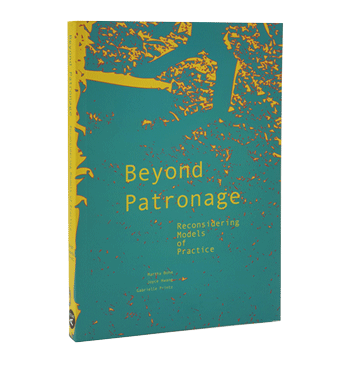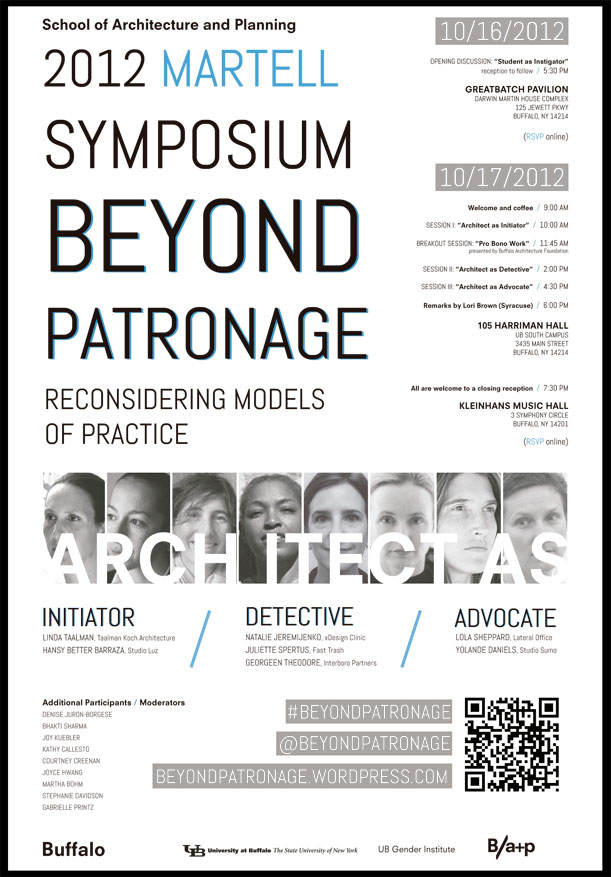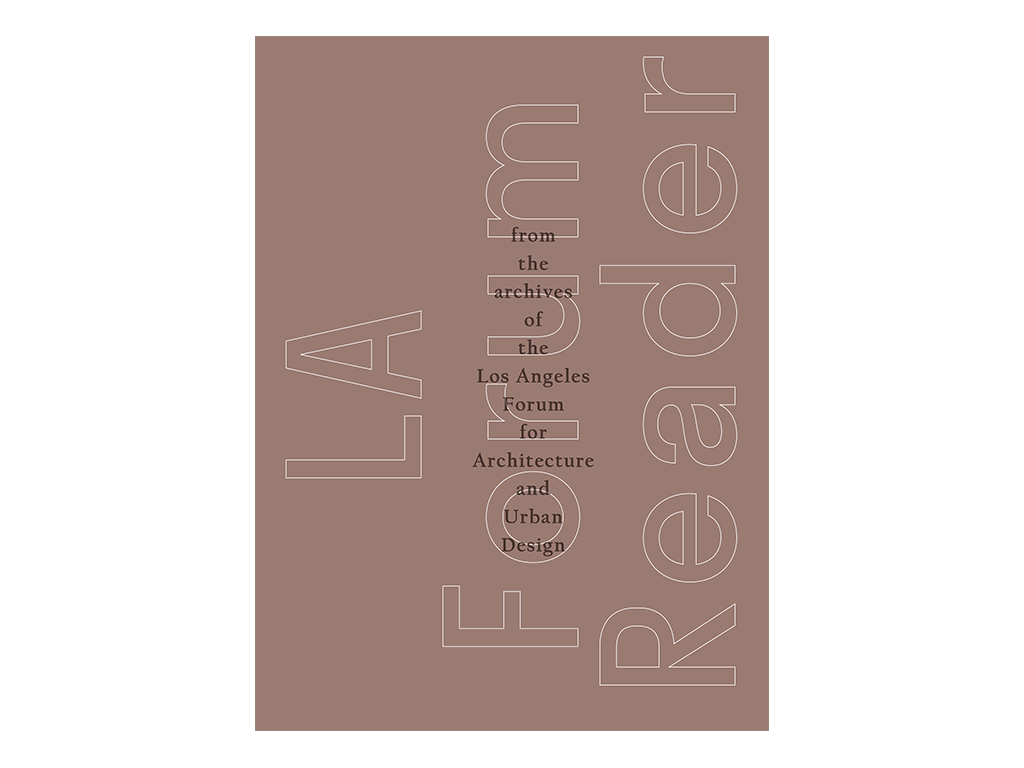One could argue that the profession of architecture has traditionally been characterized by patronage. Throughout the twentieth century, wealthy private clients have enabled architects to develop and realize their most significant work. Relationships between Edgar Kaufmann and Frank Lloyd Wright, Pierre Savoye and Le Corbusier, František Müller and Adolf Loos, and Phyllis Lambert and Mies van de Rohe are only a few of the many examples.
Today, the landscape of patronage is shifting. While the role of private clients is still central to the survival of the profession, an increasing number of architects and design practitioners are actively cultivating partnerships with not-for-profits, granting agencies, educational institutions, and other public organizations. At a moment when architects are feeling the urgent effects of sustained economic crises, facing both a surplus of practitioners and a dearth of clients, they are beginning to question the conventional belief that the only viable role for an architect is one that operates as a service-oriented professional in the employ of a moneyed client.
Why move beyond patronage?
Over several decades, the architectural profession has responded to three key challenges embedded in conventional modes of patronage-based practice. Practitioners have arguably begun moving beyond patronage while seeking ways of bringing about architectures which reflect a more progressive set of values and priorities in the realms of ecology, economics, and equity.
First, from the emergence of the environmental movement in the late 60s, to the rise in the 90s of the current sustainability effort, there has been a growing understanding that the natural environment is adversely affected by normative patterns of development. Architecture has several times over developed modes of working where conservation, or indeed even regeneration of the natural environment through the creation of built work, is an objective of design. While sustainable design has entered the mainstream mode of architectural practice, some practitioners have gone further, essentially reconstructing their work around the environment as ultimate ‘client.’ This reframing broadens the role and purview of the designer to understand and engage consequences and externalities typically unaddressed in her work, and allows the instigation of design for a non-traditional (and non-paying) patron.
A second challenge facing architecture is the powerlessness of the profession against economic fluctuations. Exacerbated by recent decades’ celebration of “starchitects” as high-profile members of a design noblesse is the perception of architecture as a luxury good, one for which investment is cut back when belts tighten generally. The recession sparked by the 2008 financial crisis hit the profession hard in the US; as of 2012 several signs pointed to recovery, and architectural unemployment, while higher than typical for recent graduates, had begun to fall (European firms, on the other hand, continued to struggle). While the recent ebb is more extreme than others, the economies of the profession are cyclic, and lean times breed inventiveness.
In our eyes, a last significant challenge to the profession is the glaring inequity between the haves (the profession’s typical patrons and clients) and the have-nots — or, put another way, between the wealthiest 1% who can afford architectural services, and the 99% who cannot. Responses to this might be traced back as far as the social programs of early Modernism, or to the global awareness concurrent with the environmental awakening of the ‘60s. Practitioners have recognized that those who cannot afford their services do still need them, and many more beyond patronage practices have arisen since the economic crisis.
Emerging Questions
The emergence and proliferation of these new, dynamic relationships in contemporary architectural practices incite a number of questions: How are these broader relationships between architects and organizations redefining the role of patronage in architecture? How have emerging forms of patronage shaped or enabled design practices, influenced design processes, or instigated agendas of research within the work of architects? Have our current economic, ecological, and political climates provoked architecture to confront its own priorities and assumptions? If so, how are architects rethinking models of practice? How can the practice of architecture be shaped not only through relationships of power, but also through strategies of empowerment? What are emerging trajectories of reconsidering ‘patronage’ — and their processes and consequences — in architectural and design practices today?
To explore these questions, we initiated a platform for discussion in 2012: The Martell Symposium — Beyond Patronage: Reconsidering Models of Practice. This was a full-day event, held at the University at Buffalo, State University of New York, to which we invited a number of architects, designers, and scholars to speak about their work. While there were many overlaps in approaches and agendas among the participants, we developed three distinct categories of ‘architect-types’ to organize the day. These were:
1. Architect as Initiator:
These are architects who enable their practices by restructuring project and business models to initiate new ways of approaching architectural practice. In the symposium, the speakers in this session — Linda Taalman and Hansy Better-Barraza — discussed strategies for creative entrepreneurship, ways of initiating exploratory projects alongside conventional business structures, and how innovative collaborations enable new design possibilities.
2. Architect as Detective:
These are architects who deploy strategies for critical observation and research to reveal the unknown. In their work, they visualize the invisible to make the case for instigating projects where opportunities did not previously exist. The speakers in this session — Georgeen Theodore, Juliette Spertus, and Natalie Jeremijenko — discussed how researching hidden conditions can lead to opportunities for further design engagement.
3. Architect as Advocate:
These are architects who critically consider the clients and audiences they serve. They reach out to communities and individuals beyond our conception of the ‘typical’ client, and discover ‘clients’ where none were thought to exist. The speakers in this session — Lola Sheppard and Yolande Daniels — discussed projects wherein they attempted to advocate for under-represented ‘client bases.’
Lori Brown concluded the symposium by examining the parallels and convergences of this group of speakers, and the potential futures of reconsidering patronage in architectural practices. An underlying current in the symposium addressed issues of gender imbalance in the profession of architecture — very poignantly summarized by Lori’s talk — and how emerging practitioners are grappling with issues of inclusion and exclusion in the field.
Here there is a documentation and reflection of the Beyond Patronage symposium. But it is also a forum for expanding the discussion to invoke new ideas and voices. Through a collection of essays and conversations, our hope is that this volume will tackle two somewhat divergent aims.
First, we want to convey a body of collective knowledge of how one might explore alternative strategies for ‘operating’ as an architect. What are the salient tactics and methods that designers are pursuing in their practices today? For example, what new forms of connectivity — technological or social — produce innovative modes of collaboration? What are ways of cultivating relationships that allow us to rethink typical hierarchies of those in power and those in service? How does one initiate projects that are not driven by consumer agendas, but instead address interests of “The Other 99%?” What are strategies for transcending the typically exclusive networks of ‘advancement’ in the field of architecture?
Second, we want to develop an anthology that highlights an inspiring group of designers and thinkers. The contributors to this book drive their practices with intense social, political, and ecological agendas. Yet their sense of purpose does not end with speculation and theory. Rather, they are activists who interrogate the terrain of architectural practice by realizing projects, constructing relationships, and activating communities in the world.
Through this anthology, we expose and initiate new priorities and strategies for architecture as a field of research and practice. Architect as Initiator, Architect as Detective, and Architect as Advocate are categories that serve as frameworks for discussion. But they can also begin to act as provocations in developing an increasingly diverse range of possibilities for how architects construct their roles, responsibilities, and ultimately, identities.













